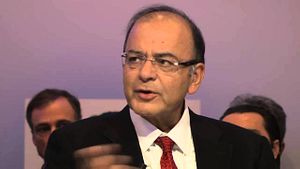It’s early spring and that means India’s national budget session is in the air. The Indian government will be formally presenting its budget for the next fiscal year on Monday. Last year’s $290 billion budget, as I discussed in The Diplomat at the time, showcased a gradualist approach to reforming India’s fiscal policy. The 2016 budget is the third to come out of Indian Prime Minister Narendra Modi’s government since it came to power in 2014.
Modi, who was elected on a platform of good governance and economic reform, has come under increasing pressure from voices both within and outside of India to deliver on important fiscal and structural reforms after his first 20 months in office. As a result, the 2016 budget will be closely scrutinized by Indians and international investors alike. Over the last year, the Modi government fell short of its own nominal and real GDP growth targets, but, partly due to the windfall from lower oil prices, kept its fiscal deficit in check.
Additionally, the Indian government’s tax receipts were in line with targets. Amid a slowdown for every other major emerging economy, India has stood out as a strong performer. Next year’s budget offers insight into where the Modi government sees challenges and opportunities, and how it’ll plan to allocate resources.
As of Friday, a lot of the conversation surrounding the budget has focused on the budget for the Indian Railways, the world’s largest employer with 1.4 million employees. Suresh Prabhu, India’s union minister for railways, presented his ministry’s budget before the country’s parliament on Thursday. (For last year’s railway budget, see: “India Reveals Ambitious Railway Improvement Plans.”) The Times of India has a useful breakdown of the highlights from Prabhu’s presentation, but, in broad strokes, next year’s railway budget will iterate on the 2015 budget, which charted a path of modest reform for India’s railways.
Prabhu noted that traffic and freight receipts for Indian Railways had fallen over last year, but he remained optimistic that overall growth in the Indian economy over next year would make its way to the coffers of Indian Railways. Prabhu additionally proposed a range of fixes that would improve bureaucratic processes and streamline Indian Railway’s finance, and improve and upgrade existing infrastructure.
Critically, Prabhu left freight and passenger fares unchanged. The Modi government, in its first two budgets at least, has done away with populist fare decreases that financially stress Indian Railways, but pay political dividends. (India’s Business Standard and Live Mint have helpful reactions to Prabhu’s 2016 railways budget.)
Finance Minister Arun Jaitley will unveil the rest of the budget on Monday. Overall, it seems that the government’s budget for next year will build on the themes it had outlined in its 2015 budget. Importantly, we may see a loosening of the government’s fiscal deficit target. Rising wages and increased stress from public pensions, including military pensions, could have repercussions for fiscal consolidation. Jaitley will likely also unveil moderate tax reforms to ease the path for an implementation of the controversial Goods and Services Tax (GST), which has been quagmired in Indian legislative politics for months. Modi’s Bharatiya Janata Party (BJP) is trying to muster political support for a GST bill, which would simplify India’s federally stratified taxes under a single regime.
Defense will be an area of scrutiny in this year’s budget, as usual. Reports suggest that we’ll see a fairly modest 9 percent increase in the allotted budget, with a large tranche of that increase going toward supporting pension payments. The Economic Times notes that taking civilian pensions and expenses into account, the total budget increase for India’s defense will probably be closer to 13 percent over last fiscal year.
Curiously, Jaitley is doing something unusual for an Indian finance minister this weekend and meeting with a panel of economists ahead of his budget presentation. Speculation about Jaitley’s reasons varies, but it’s likely that Jaitley is seeking some last minute guidance on the costs of the government abandoning its fiscal deficit targets for the next fiscal year and possibly beyond. The Modi government has been eyeing a fiscal deficit target of 3 percent of GDP for a while now, but it could look to revise the timeline for getting there amid new short-term priorities that would benefit from looser fiscal consolidation targets.
Finally, many expect this year’s budget to place a greater emphasis on India’s agriculture section, which has struggled under poor monsoons for the past two years due to El Nino weather patterns. There’s a range of approaches the government could choose to pursue, but keep an eye out for announcements regarding crop insurance and irrigation cover expansion, and possible subsidies for agricultural inputs.
More radically, the government could look to extend direct cash transfers, through the Indian government’s Direct Benefit Transfer program, specifically to aid farm output and profitability. Agriculture accounts for more than 10 percent of India’s GDP and, more importantly, roughly half the country’s work force. For the government, supporting the agriculture sector is an increasingly important economic priority, but also a political one: long-term hurt for India’s agriculture sector could hurt the party at the polls.
There’ll be a lot to look for on Monday, when Jaitley presents the 2016 union budget. India has managed to break with the trend of large emerging economies succumbing to structural pressures. With a major slowdown in China and a continuing blessing from low oil prices, India has a lot to gain from sustained performance. For Modi, who has made marketing India’s economic promise a regular feature of his trips abroad, the budget unveiling will be an opportunity to restore confidence in his reform program and show international investors and credit rating agencies alike that India’s economy will remain under control.

































